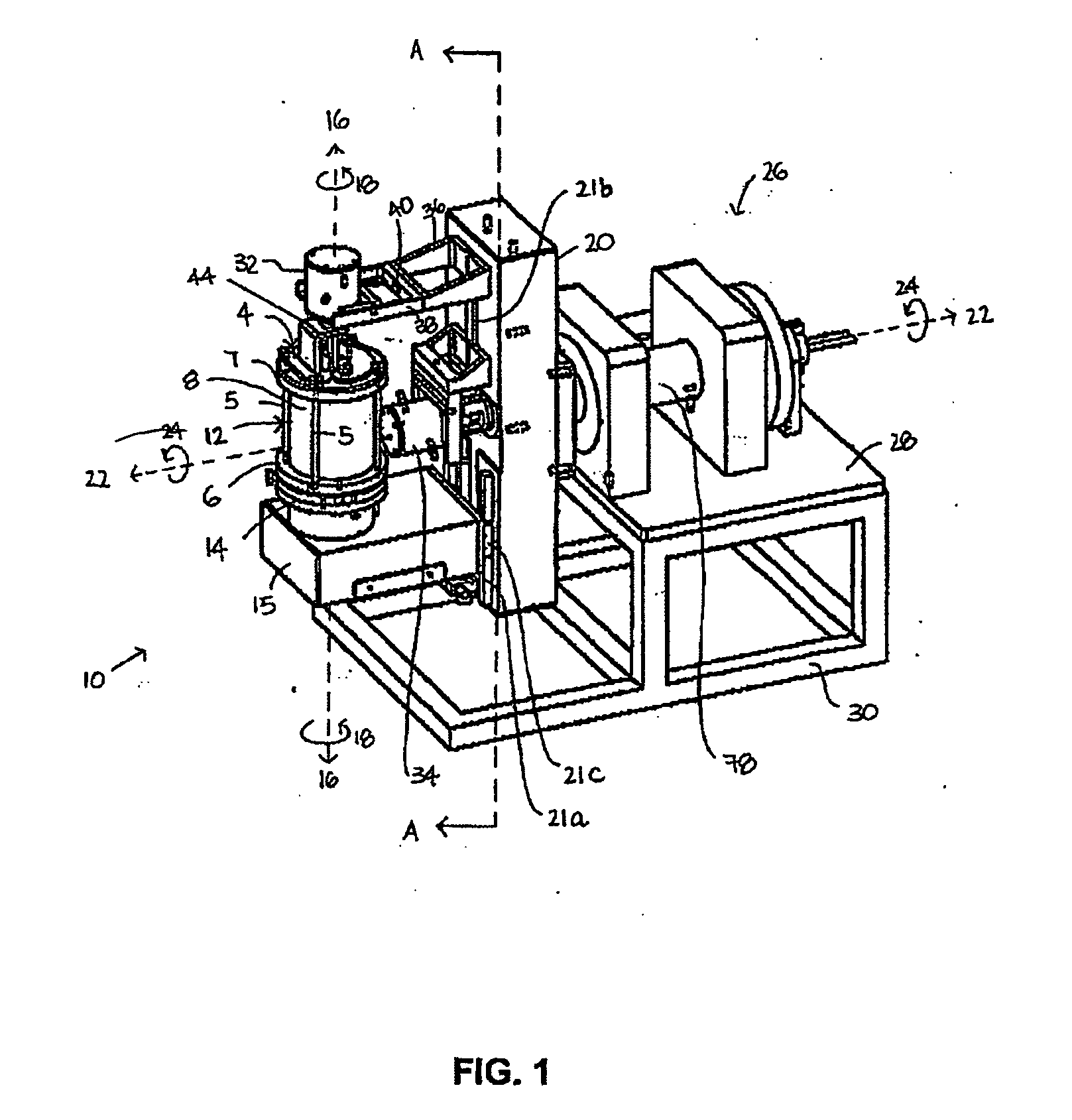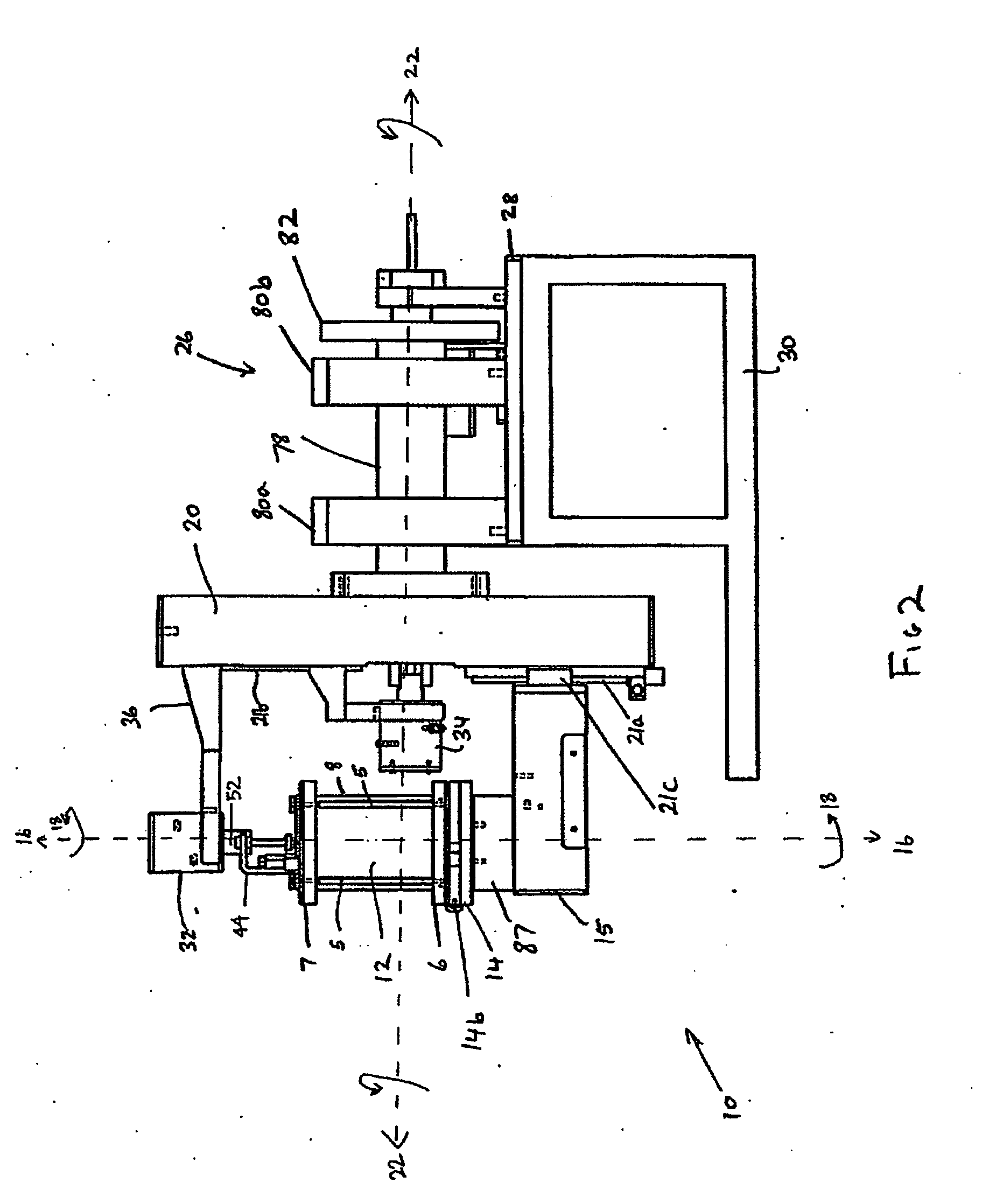Bioreactor for growing cell or tissue cultures
a technology for growing cells and tissue, applied in the direction of microorganisms, rotary stirring mixers, after-treatment of biomass, etc., can solve the problems of not providing a constant and regulatory supply of nutrition and removal, functionally different from naturally grown cells, and fibrous scarring of tissue, etc., to facilitate cell and tissue growth.
- Summary
- Abstract
- Description
- Claims
- Application Information
AI Technical Summary
Benefits of technology
Problems solved by technology
Method used
Image
Examples
embodiment 1
oreactor
[0172]FIG. 1 shows a perspective view of a first preferred embodiment of a dual axis bioreactor 10 that is used to grow cell or tissue cultures. The bioreactor 10 includes a chamber 12 for containing a cell or tissue culture and a culture medium for growing cell or tissue cultures in use. The bioreactor 10 also includes a drive mechanism 26 for rotating the chamber 12 at a first speed about a first vertical axis 16 and at a second speed about a second horizontal axis 22. The horizontal axis is normal relative to the vertical axis. As will be described further below, in use, the magnitude of the first speed and the second speed are independently variable of each other to thereby grow a cell or tissue culture within the chamber.
[0173] Referring to FIGS. 1, 2, 2a, 3, the chamber 12 may be provided with a three-dimensional matrix (not shown) when growing three-dimensional cell or tissue cultures as will be described further below. The chamber 12 includes a glass tube 8 having t...
embodiment 2
oreactor with Spherical Chamber
[0237] As an alternative to the cylindrical chamber 12, the dual axis bioreactor 10 of embodiment 1 can be replaced with a spherical-shaped chamber 512 shown in FIG. 39. The spherical chamber 512 comprises of a spherical cavity 510. The spherical cavity 510, in use, contains a cell or tissue culture medium, scaffold for cell or tissue culture and cell or tissue of interest. On the outer surface the spherical cavity 510, there are provided hooks (511a, 511b, 511c and 511d) for fixing the cylindrical chamber to the L-shaped bracket 20. The spherical chamber 512 is fixed to the rotary plate 14 by means of cylindrical rods (5a, 5b, 5c and 5d) which respectively extend from the rotary plate to the hooks (511a, 511b, 511c and 511d).
[0238] The spherical chamber 512 is also provided with a conduit 550 that extends from the cavity 510 up to a bottom chamber clamp plate 509. The bottom chamber clamp plate 509 is capable of being fixed to a top chamber clamp pla...
embodiment 3
onal Rotary Bioreactor
[0244] Referring now to FIG. 35 there is shown a perspective view of another embodiment of a bioreactor for growing cells and tissue cultures, here called an “omni-directional rotary bioreactor 318”. The bioreactor 318 includes a chamber 302 for containing a cell or tissue culture and a culture medium for growing cell or tissue cultures in use. The bioreactor 318 also includes a rotary wheel in the form of wheel 314 (shown in FIG. 36b) for rotating the chamber 302 at a first speed about a first axis 319. The bioreactor 318 also includes a second rotary wheel in the form of wheel 315 for rotating the chamber at a second speed about a second axis 320. The bioreactor 318 also includes a third rotary wheel in the form of wheel 311 at a third speed about a third axis 321. The axes 319, 320 normal relative to each other and both axes are normal relative to the third axis 321. As will be described further below, in use, the magnitude of the first speed, second speed a...
PUM
| Property | Measurement | Unit |
|---|---|---|
| angle | aaaaa | aaaaa |
| angle | aaaaa | aaaaa |
| rotation | aaaaa | aaaaa |
Abstract
Description
Claims
Application Information
 Login to View More
Login to View More - R&D
- Intellectual Property
- Life Sciences
- Materials
- Tech Scout
- Unparalleled Data Quality
- Higher Quality Content
- 60% Fewer Hallucinations
Browse by: Latest US Patents, China's latest patents, Technical Efficacy Thesaurus, Application Domain, Technology Topic, Popular Technical Reports.
© 2025 PatSnap. All rights reserved.Legal|Privacy policy|Modern Slavery Act Transparency Statement|Sitemap|About US| Contact US: help@patsnap.com



